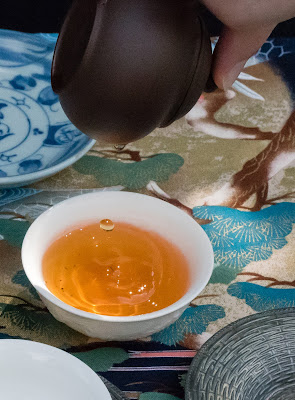Jean-Luc Lanoix est un
caviste passionné à Haguenau, en Alsace. Il y a 4 ans, il m'avait fait découvrir les
vins naturels et de nombreuses informations pratiques pour bien déguster du vin. Cette dégustation vins et fromage fut un tel succès dans ma famille que nous en faisons une à chacun de mes retours en France.
Lors de la première session, un grand nombre de vins nous avait été proposé par M. Lanoix avec un fromage par bouteille et nous avions trouvé les accords entre les deux de très grande qualité. Chaque vin se mariait particulièrement bien avec le fromage proposé pour l'accompagner. C'est à cette occasion que nous découvrîmes l'excellent Fleur de maquis, fromage de brebis Corse, malheureusement introuvable sur l'autre ile de beauté nommée Formose!... Nous fîmes honneur aux excellents produits des terroirs de France dans un repas qui faisait écho aux festins de Pantagruel ou de Porthos!

Ravis par ces voyages gustatifs en pays de Loire, de Languedoc et de Provence, nous finîmes la soirée un peu étourdis et chancelants lorsqu'il fallut abandonner nos chaises pour affronter le tangage de la terre peu ferme sous nos pas. L'alcool qui grise ne reste un plaisir que si il est consommé avec une modération qui variera d'une personne à une autre. Connais-toi toi-même (et tes limites) est l'adage de philosophie pratique de tout dégustateur de vin!
Pour cette édition de 2017, M. Lanoix nous propose une découverte des blancs de Bourgogne! Connaissant surtout les blancs d'Alsace, je trouve le thème fort bien choisi. Cette fois, au lieu d'avoir 1 fromage par bouteille, il y en a eu 2. Ce changement fut intéressant, car il permit de constater quel fromage allait le mieux avec le vin proposé.
En dernière minute, j'ai l'idée d'essayer de compléter cette dégustation vins et fromages par du thé! A chaque bouteille, je demande le profil gustatif du vin et des fromages et essaie de trouver un thé qui puisse s'accorder.
La dégustation de vins et de thés partagent cette même règle: aller du
plus léger au plus lourd. Aussi, comme M. Lanoix commence souvent par des 'bulles' (crémant ou Champagne), je choisis
mon thé blanc le plus simple pour lui répondre. Je n'ai malheureusement pas une bonne mémoire des fromages et ne saurait vous dire quels accords fonctionnèrent le mieux ou le nom exact des fromages. Mais, avec 2 fromages par vin, il y en avait toujours un qui fonctionnait mieux que l'autre avec le vin et/ou le thé.
Le bon accord, c'est quand les 2 produits, vin et fromage ou thé et fromage se répondent et se complètent. Chacun est bon, mais les deux ensemble donnent des sensations qui vont au-delà de la simple somme des 2. Un mauvais accord, c'est quand la combinaison des deux est moins satisfaisante que la consommation d'un seul.
En second thé, je pris mon
top Lishan Oolong. Puis, pour le troisième round, j'infusai mon
top puerh cru sauvage de 2017. J'ai la satisfaction que ce thé impressionna notre caviste, M. Lanoix, par l'expression de sensations de
terroir et la longueur en bouche de cette infusion. Je l'avais infusé
plutôt fort afin que les arômes du thé ne soient pas écrasés par ceux du
fromage. Et comme il fonctionna si bien, je le réinfusai pour le
prochain tour.
Pour accompagner les fromages destinés au vin rouge, je choisis un Hung Shui Oolong avec quelques tannins et bien structuré. Infusé de manière concentrée, c'est un festival d'arômes maltés, mielleux et grillés. Très différent d'un vin rouge, tout de même, ce thé accompagnait bien le fromage qui allait le moins bien avec ce vin.
Tout à la fin de la dégustation, M. Lanoix nous fit découvrir un vin blanc d'Alsace tellement particulier que nous pensions tous qu'il s'agissait d'un vin jaune jurassien! Aussi, j'infusai un vieux
puerh '7542' de 1999 pour rester dans la complexité, les arômes riches et exceptionnels de ce vin.
Nous passâmes de superbes moments raffinés au sommet de ce que la terre, le ciel, les animaux et les hommes produisent de mieux! Cette soirée n'aurait pas été possible sans mon beau frère bourguignon, Jérome et je tenais à le remercier pour sa généreuse amitié.
L'ajout de thé à cette dégustation fut bénéfique aussi pour nos sens, moins grisés et mieux conscients que lors des sessions précédentes. Le thé semblait avoir aidé à la digestion et à atténuer les effets de l'alcool, à moins que boire du thé ne réduise simplement la consommation de vin... Mais l'important est d'avoir su passer une excellente soirée à partager plaisirs, passion et amitié!



























































